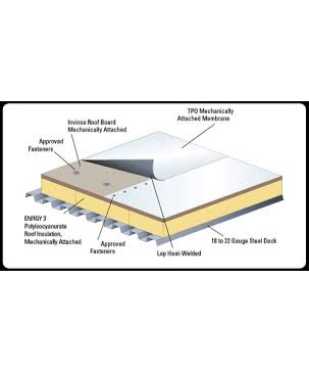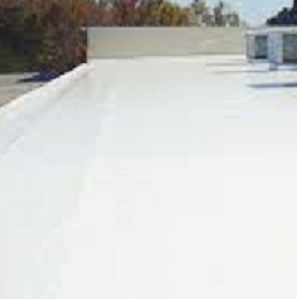Quality Tpo Roof Replacement in Balch Springs
✅Call (214) 225-3150. We are a full service Balch Springs TPO ROOF REPLACEMENT company that provides mold testing to help protect you and your family from mold.

What is TPO Roofing?
Thermoplastic Polyolefin is a single-ply roofing membrane that is one of the fastest growing commercial roofing systems on the market. TPO roofing systems are made up of a single layer of synthetics and reinforcing scrim that can be used to cover flat roofs.
- TPO polymer base.
- polyester-reinforced fabric center (scrim).
- thermoplastic polyolefin compounded top ply.
Benefits of TPO Roofing
- Economical
- Fits different home styles
- Durable
- Ease of installation
- Energy Efficient
How to identify a TPO Roof
Determining what your RV roofing material is can be done in just a few easy steps. First find an overhead roof vent, unscrew and take off the vent trim ring and find a section of the roofing material. Take out a staple to check the back side. If the front is one color but the back is black, you have an EPDM roof, but if both sides are the same color, you have a TPO roof.
How long does TPO roof last in balch springs #state#?
30 years. The main advantage of having a TPO roofing system is that it is UV-resistant, and can help reduce home energy consumption. If installed properly and maintained well, a TPO roof should last up to 30 years. Material Warranty Period: Up to 25 years. TPO roof system life expectancy
Is TPO roofing toxic?
Thermoplastic olefins produce less toxic agents and environmental pollution during incineration than typical residential refuse. During incineration, the material is transformed into a form of slag, which can be deposited in a landfill with no adverse environmental effects.
Is a TPO roof good?
TPO is very good at resisting dirt build-up, punctures, and tears as well. The use of TPO on your roof can mean lower cooling costs due to UV resistance. While TPO is energy efficient, it is also made from environmentally friendly products. So, TPO can actually help to lower carbon emissions.
Is TPO waterproof?
TPO is mostly used for low slope commercial roofing along with other materials: Felt – They are waterproof and cost-effective.
How thick is TPO roofing?
TPO is typically sold in thicknesses of 45 mil, 60 mil and 90 mil. In Indiana, we typically see 45 mil and 60 mil specified. The thicker the membrane, the better the long term durability.
Is TPO better than EPDM?
EPDM has a dark surface, which in summer conditions will absorb heat, forcing cooling systems to work overtime, whereas TPO roofing reflects sunlight, allowing commercial air conditioners to work more efficiently. TPO also has a somewhat higher resistance to punctures than EPDM.
Who makes the best TPO roofing?
You should look for a brand that can withstand heat and can last many years. You should also go for TPO roofing because it is cost-effective and easy to maintain. With all the brands that Structural Research Inc. (SRI) had tested, GAF's EverGuard® and EverGuard Extreme® are said to be the best.
Does EPDM have to be glued down?
While the rubber roofs are known to be durable, they also need maintained. EPDM roofs are fully adhered or as many call it glued down. The system is not attached mechanically. If you are set on a rubber roof, make sure the roofing contractor is fully trained and experienced in installing a rubber roof.
Is TPO more expensive than EPDM?
TPO is less susceptible to leaks. Since TPO roofs don't have big seams like EPDM roofs, this makes them less vulnerable to water leaks as they age. TPO can be slightly cheaper than EPDM — Comparing standard TPO roofing vs. EPDM roofing, the price is fairly comparable.
What does a TPO roof cost?
For a decent quality TPO membrane, pricing starts at $7.50-8.00 per square foot installed, without tear-off. For example, if you have a 1,500 sq. ft. roof, you total installation cost for TPO will be $11,500-12,000.
- Roof condition
- Roof size
- Roof access
- Insulation selection
- Membrane selection
- Installation options
- Roof protrusions/penetrations
- Warranty options
- Benefits of TPO
Is TPO roofing good?
TPO is very good at resisting dirt build-up, punctures, and tears as well. The use of TPO on your roof can mean lower cooling costs due to UV resistance. While TPO is energy efficient, it is also made from environmentally friendly products. So, TPO can actually help to lower carbon emissions.
What is the best roofing for a flat roof?
PVC roofingFor many projects, PVC roofing is our preferred choice as the best flat roof material on the market. PVC roofing is somewhat more expensive than other single-ply commercial roofing materials, however it offers a wide range of benefits for the price.
How do you repair a TPO roof?
TPO roofing membrane repairs can be made by several methods, depending on the type of repair needed:Scoring surface with a kitchen scrubber, priming with TPO primer and using M1 sealant.Scoring surface with a kitchen scrubber, clean with Eternaclean, and sealing with Eternabond RoofSeal roof repair tape.
What is best covering for flat roof?
Ethylene Polypropylene Diene Monomer (EPDM) is one of the most versatile rubber roofing options on the market. Considered to be one of the best materials for flat roofs, rubber is a popular choice for industrial and commercial applications thanks to its ability to withstand extreme weather conditions.
What is the difference between TPO and PVC roofing?
TPO roofing membranes consist of an ethylene or polyethylene thermoplastic bound to ethylene propylene rubber. PVC roofing membranes are made by polymerizing vinyl chloride monomers, then adding plasticizers to increase flexibility.
How do you maintain a TPO roof?
TPO Cleaning Tips for Roofers who do the cleaning often start with a low-pressure wash on the top layer of the membrane, removing any dust and dirt. Then, they will use a soft-bristled, long-handled brush to scrub the cleaning solution onto the surface, ensuring not to damage the TPO material.
How do I know if I have EPDM or TPO?
An EDPM rubber roof will be very slippery when wet, while a #TPOroof is not. TPO is also very glossy while EPDM is not. The texture may also give some clues as to what type of roof is on your RV or camper. EPDM is very smooth, while TPO may be slightly bumpy, similar to an orange peel.
What does a TPO roof look like?
The most common TPO material is bright white with highly reflective properties. This bright white roof installation can reflect UV rays and heat from the building, saving money during the summer months from decreased energy usage to cool the building interior.
Is sarnafil a TPO roof?
Over 35+ years of performance history from Sika, the creators of Sarnafil and the world leader in producing thermoplastic roof membranes.
Tpo Roof Replacement 75180 75181 75217 75253Balch Springs Tpo Roof Replacement
Learn more about mold inspection
Industry organizations:
Balch Springs
Balch Springs ( BAHLK, BAHLTCH) is a cities in Dallas County, Texas, United States. It is an inner-ring suburb of Dallas and part of the Dallas–Fort Worth metroplex. The population was 23,728 at the 2010 census, and 25,007 at 2019's census estimates.

Xpert Texas of Balch Springs,
Important information for Balch Springs Dallas County 25210
-
City: Balch Springs, State: 3021 Hickory Tree Rd, Balch Springs, TX 75180-1623
-
Latitude: 32.72874,Longitude: -96.62277
| Mold Remediation |
| Mold Inspection |
| Fire Restoration |
| Disinfection Services |
| All About Balch Springs Texas |
| Balch Springs Neighborhoods, Restaurants and Hotels |
Why Choose Us?
- Very Experience
- Open 24 Hours Everyday
- Fast Arrival Time
- Competitive Pricing
- Accepting Credit Cards
- Quick and Honest Service
- Excellent Customer Service
- Commitment and Promise
- Embrace New Technology
- Bastrop, TX
- Crane, TX
- Donna TX
- Garden Ridge TX
- Justin TX
- Midlothian TX
- Perezville TX
- Salado TX
- Timberwood Park TX
- Southlake TX

Services Offered in Balch Springs
3021 Hickory Tree Rd, Balch Springs, TX 75180-1623
Governor's Hill At Barton Creek, Downtown Austin, North Austin, South Congress, East Austin, Allandale, Bouldin Creek, Barton Hills, St. Edwards, Circle C Ranch, Avery Ranch, East Riverside - Oltorf, Dove Springs, Northwest Hills, Montopolis, Old West Austin, Travis Heights, Anderson Mill, Southeast Austin, Hardrock Canyon, Central Austin, Tech Ridge Center, Travis Country, Pemberton Heights, Red River Cultural District, Mueller, Greater South River City, East Cesar Chavez, Great Hills, Govalle, Austin Hills, Tarrytown, Bryker Woods, North Burnet, Tanglewood Forest, North University, Village At Western Oaks, Gracywoods, South River City, Clarksville, Meadows Lake, Central East Austin, Colorado Crossing, North Burnet–Gateway, Triangle State, Davis Spring, North Austin Civic Association, North Shoal Creek, Spyglass-Barton's Bluff, Jester Estates, Seaholm District

